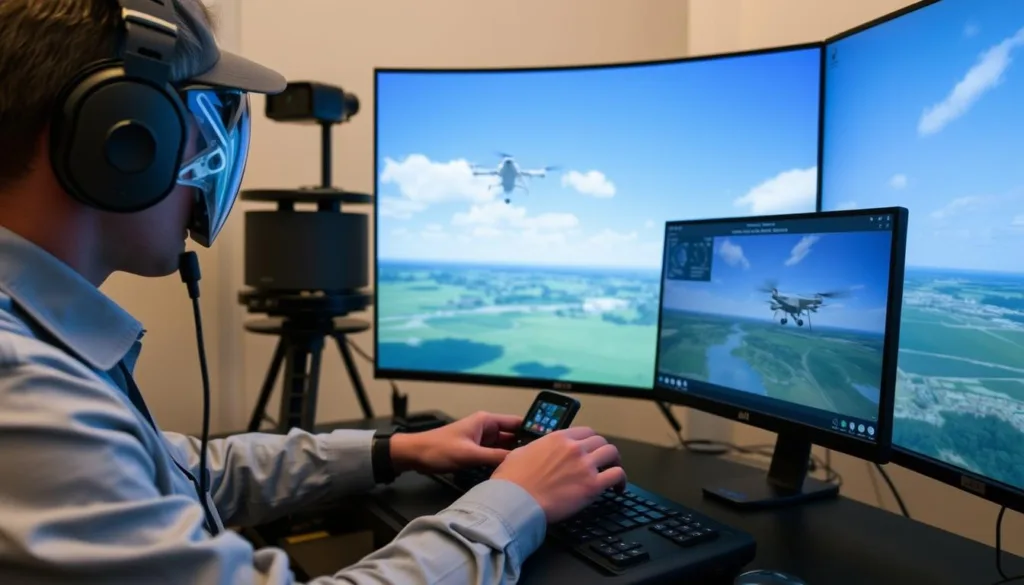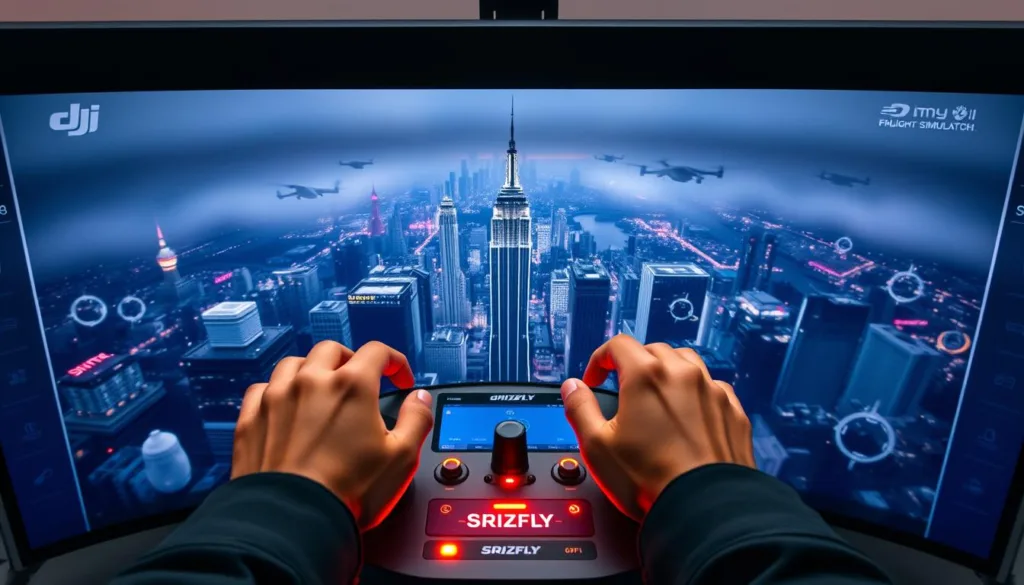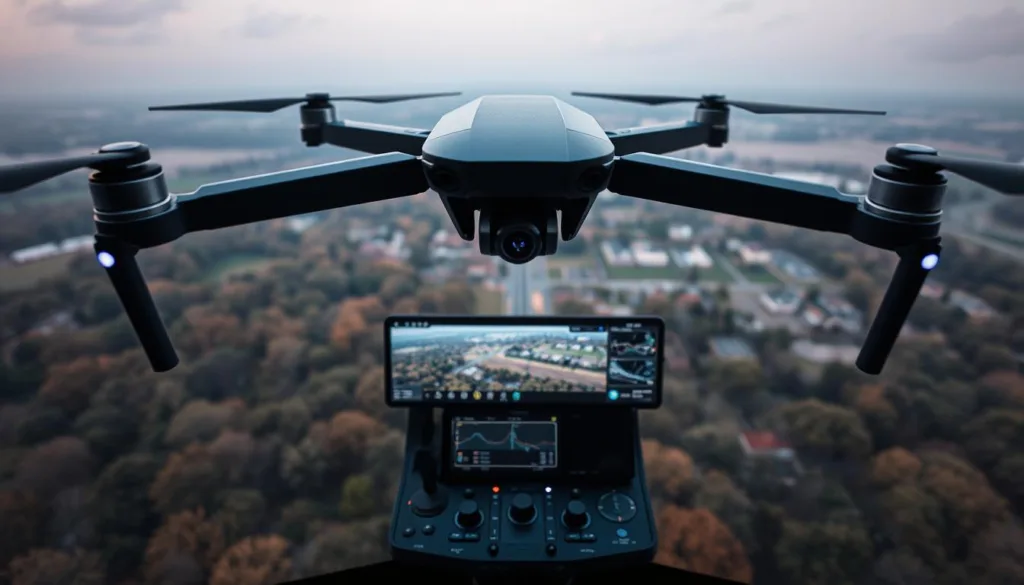The DJI Virtual Flight Simulator is a comprehensive software tool designed for drone enthusiasts and pilots to hone their flying skills in a risk-free virtual environment.
This innovative tool allows users to practice various flight maneuvers, from basic takeoffs to complex aerial stunts, without the fear of crashing or damaging their drones.
By utilizing the DJI Virtual Flight Simulator, pilots can become familiar with the handling characteristics of their aircraft, significantly reducing the learning curve and the risk of costly accidents.
Key Takeaways
- Practice flying in a risk-free virtual environment.
- Master various flight maneuvers without damaging your drone.
- Familiarize yourself with your aircraft’s handling characteristics.
- Reduce the learning curve and risk of accidents.
- An essential tool for both beginner and experienced drone pilots.
Understanding the DJI Virtual Flight Simulator

The DJI Virtual Flight Simulator offers a safe and controlled environment for pilots to hone their skills. This software is designed for virtual drone training, allowing users to practice flying with accurate representations of various DJI drone models. By utilizing the simulator, pilots can eliminate the stress and anxiety associated with flying an expensive drone for the first time.
Benefits of Risk-Free Drone Training
Virtual drone training provides numerous benefits, including a risk-free environment where pilots can experiment with advanced FPV techniques without damaging expensive equipment. The simulator accurately replicates the flight characteristics of different DJI drones, ensuring that skills learned virtually transfer effectively to real-world flying scenarios.
- The DJI Flight Simulator provides a comprehensive virtual training environment.
- Virtual drone training eliminates stress and anxiety.
- The simulator accurately replicates flight characteristics of DJI drones.
Srizfly's Official Partnership with DJI
Srizfly, a top drone simulation provider, has an official partnership with DJI to offer the official DJI Flight Simulator. This partnership ensures that the simulator remains up-to-date with the latest drone models and controller configurations, providing users with the most authentic virtual flight experience possible.
- Srizfly’s partnership ensures the simulator is updated with the latest DJI drones.
- The simulator maintains deep compatibility with all DJI products.
- As DJI’s official simulator reaches the end of its update cycle, Srizfly becomes the only officially recognized alternative.
System Requirements and Technical Specifications
To get the most out of the DJI Virtual Flight Simulator, understanding its system requirements is crucial. The simulator is designed to provide a realistic and immersive experience, but this requires a computer that meets specific hardware and software standards.
Minimum and Recommended Hardware Setup
The DJI Virtual Flight Simulator demands a robust hardware configuration to operate smoothly. At a minimum, it requires a G4560 processor, GTX1050 Ti graphics card, 16GB RAM, and 80GB of free hard disk space. For a more immersive experience, the recommended specifications include an i5-6400 processor, GTX1060 or GTX1070 graphics, 16GB RAM, and an SSD with 80GB of free space. For the ultimate experience, DJI suggests using an i7-7700 processor, GTX1080 Ti graphics, 32GB RAM, and an SSD with 80GB of free storage.
Compatible DJI Drone Models and Controllers
The DJI Virtual Flight Simulator is compatible with a range of DJI drone models, including the Phantom 4 series, Mavic series, Inspire models, and various enterprise drones. This compatibility allows users to train with virtual versions of their specific aircraft, enhancing the realism of the simulation. The software is designed to work with authentic DJI remote controllers connected via USB, providing the most realistic control experience possible. It’s worth noting that the simulator does not support third-party controllers or game controllers, emphasizing DJI’s focus on creating an authentic training environment.
The simulator is exclusively designed for Windows 10 64-bit operating systems, with no current support for Mac or Linux platforms. Storage requirements are substantial, at 80GB, with an SSD strongly recommended for faster loading times and smoother performance during complex flight scenarios.
Getting Started with DJI Virtual Flight PC
Embarking on your DJI Virtual Flight PC journey begins with downloading the software from the official DJI website. This ensures you’re getting the authentic and most up-to-date version of the DJI Flight Simulator software.
Downloading and Installing the Software
The process of downloading and installing the DJI Virtual Flight software is straightforward. Navigate to the DJI website, locate the download section, and select the appropriate version for your Windows PC. Once downloaded, follow the installation prompts to set up the Virtual Flight app on your computer.
Creating or Logging into Your DJI Account
To activate the software, you’ll need to either log in with your existing DJI account or create a new one. The Standard version of the software allows installation on multiple computers, but it can only be used on one device at a time. This flexibility is convenient for users who work on different PCs.
Initial Configuration and Settings
After installation, configure your preferences for graphics quality, control sensitivity, and other parameters that affect the simulation experience. Connecting your DJI remote controller via USB is a crucial step for an authentic flying experience. The software provides various training scenarios and environments, allowing you to customize your learning based on your skill level and goals.
By following these steps, you’ll be well on your way to mastering the DJI Virtual Flight PC and enhancing your drone flying skills in a safe, virtual environment.
Remote Controller Connection and Setup
A key part of using the DJI Virtual Flight Simulator is linking your remote controller to the software. This connection enables you to control the simulated drone with the same precision and feel as you would with a real DJI drone.
USB Connection Guidelines
To establish this connection, you’ll need to use a USB cable to link your remote controller to your computer. The location of the USB port on your controller may vary depending on the specific DJI drone model you’re using. For instance, the Phantom 4 series and Matrice 600 Pro have their USB ports located on the back, while the Mavic Air’s is on the left side. As noted, “The USB connection process varies slightly depending on your specific controller model, with ports located in different positions across the DJI product line.”
Controller Calibration Steps
After connecting your remote controller, you’ll need to calibrate it within the DJI Virtual Flight software. This step is crucial for ensuring that your controller inputs are accurately translated into actions within the simulator. The calibration process involves moving the controller sticks through their full range of motion and testing the functionality of the buttons. As emphasized, “Controller calibration is an essential step that ensures your inputs are accurately represented in the virtual environment, creating a more realistic and effective training experience.”
By properly connecting and calibrating your remote controller, you’ll be able to enjoy a more immersive and realistic training experience with the DJI Virtual Flight Simulator. This setup helps create muscle memory that directly transfers to real-world flying, making the transition to actual DJI drone operation seamless.
Navigating the Simulator Interface
The DJI Flight Simulator boasts an interface that is both comprehensive and easy to navigate, making it accessible to drone pilots of all skill levels.
The simulator’s main menu serves as the central hub for all training activities. Here, users can select their preferred drone model, choose from a variety of training scenarios, adjust controller settings, and configure various simulation parameters.
Understanding the Main Menu and Options
The main menu is designed to be intuitive, providing clear options for users to customize their training experience. Users can select from different DJI drone models and adjust settings to match their specific needs.
Selecting Virtual Environments and Scenarios
The DJI Flight Simulator offers a diverse range of virtual environments, from open fields ideal for beginners to complex urban landscapes that challenge even experienced pilots. Users can choose scenarios that suit their skill level and training objectives.

Customizing Flight Parameters
Users can customize flight parameters to simulate different weather conditions, time of day, and other environmental factors that affect real-world drone operation. This feature allows pilots to train in a variety of conditions, enhancing their skills and preparedness.
By customizing these parameters, users can create realistic training scenarios that help them develop the skills needed for safe and effective drone operation.
Basic Flight Training Techniques
With the DJI Flight Simulator, pilots can develop essential flying skills in a risk-free environment. The simulator provides a structured approach to learning, starting with the basics and progressing to more advanced techniques.
Mastering Takeoff and Landing Procedures
Takeoff and landing are critical procedures that require practice to master. The DJI Flight Simulator allows pilots to repeatedly practice these maneuvers, building confidence and muscle memory that directly transfers to real-world drone piloting situations. By mastering takeoff and landing, pilots can ensure a smooth and safe flight experience.
As emphasized by DJI, “Practice makes perfect, and the simulator is the perfect place to hone your skills without risking damage to your drone.”
Learning Essential Control Inputs
Understanding the relationship between stick movements and drone response is crucial for precise flight. The simulator helps pilots develop the fine motor control needed for smooth and accurate control inputs. By practicing control inputs, pilots can improve their overall flying skills and respond to various flight scenarios.
Practicing Stable Hovering and Basic Maneuvers
The simulator allows drone pilots to practice maintaining stable hovering in various conditions, a fundamental skill that forms the foundation for all advanced maneuvers. Basic maneuvers such as forward flight, turning, and altitude control can be practiced repeatedly without the stress of potential crashes or equipment damage.
| Skill | Description | Benefit |
|---|---|---|
| Takeoff and Landing | Mastering critical procedures | Builds confidence and muscle memory |
| Control Inputs | Understanding stick movements and drone response | Improves fine motor control and precision |
| Hovering and Basic Maneuvers | Maintaining stable hovering and practicing basic maneuvers | Develops fundamental skills for advanced maneuvers |
By utilizing the DJI Flight Simulator, pilots can develop the skills and confidence needed to become proficient drone pilots. The simulator’s realistic physics engine and instant reset feature make it an ideal tool for learning and refining flying skills.
Advanced Flight Training Features
The DJI Flight Simulator provides an array of advanced training features designed to challenge and improve pilots’ skills. These features allow experienced pilots to push their abilities to new heights by practicing complex maneuvers in a safe and controlled environment.
Executing Complex Flight Patterns
The DJI Flight Simulator’s advanced features enable pilots to practice complex flight patterns that would be risky to attempt with a real drone. Users can create and save custom flight paths that incorporate multiple maneuvers in sequence, helping to develop the muscle memory needed for smooth, professional-looking drone footage. This capability is particularly useful for professional drone operators who need to capture specific shots for commercial projects.

FPV Drone Racing Techniques
The simulator offers specialized training for FPV drone racing, allowing pilots to practice high-speed navigation through virtual obstacle courses before competing in real-world events. The racing modules include time trials and competitive multiplayer options, creating an engaging environment for developing quick reflexes and precise control.
Simulating Emergency Situations and Responses
One of the most valuable advanced features is the ability to simulate emergency situations such as sudden wind gusts, partial power failures, or GPS signal loss. Practicing responses to these emergencies in a safe virtual environment prepares pilots to react correctly and calmly when similar situations occur during actual flights.
| Feature | Description | Benefit |
|---|---|---|
| Complex Flight Patterns | Create and save custom flight paths | Develops muscle memory for professional-looking footage |
| FPV Drone Racing | Practice high-speed navigation through virtual obstacle courses | Improves quick reflexes and precise control |
| Emergency Situations | Simulate sudden wind gusts, partial power failures, or GPS signal loss | Prepares pilots to react correctly in emergency situations |
Virtual Reality Integration and DJI Goggles Support
The combination of DJI Virtual Flight Simulator and DJI Goggles provides an unparalleled virtual reality (VR) experience for drone pilots. This integration allows for a more immersive training experience, closely mimicking the actual drone flying experience.
HDMI Connection Setup
To utilize the DJI Goggles with the Virtual Flight Simulator, users need to establish an HDMI connection between their computer and the goggles. This straightforward setup enables instant immersion in the virtual flight environment, providing a first-person view that enhances the training experience. The high-resolution displays in the DJI Goggles offer crystal-clear visuals, further enriching the simulation.
VR Experience Enhancement
While the current implementation doesn’t support head tracking, the fixed VR view still offers valuable training for FPV flight scenarios. Pilots can develop spatial awareness and instinctive control responses, crucial for real-world operations. The DJI Goggles’ battery life of up to 3 hours allows for extended training sessions, perfect for mastering complex maneuvers. By using the goggles during simulation, pilots become comfortable with the FPV perspective, reducing disorientation during initial real-world FPV flights.
Conclusion: From Simulation to Real-World Flying
The DJI Virtual Flight PC, powered by Srizfly, offers a top-notch simulation experience that helps pilots of all levels improve their skills safely and effectively. By utilizing this platform, drone enthusiasts can try out new flight skills and get ready for real drone flying without the risk of damaging their equipment.
The DJI Flight Simulator serves as a bridge between theoretical knowledge and practical application, allowing pilots to develop confidence and competence before taking their drones into the real world. The skills and muscle memory developed in the virtual environment transfer directly to actual flight operations, significantly reducing the learning curve and minimizing the risk of accidents.
As pilots progress from virtual flight to real-world flying, they’ll find that the authentic control feel and accurate flight physics of the simulator have prepared them well for the challenges of actual drone operation. The confidence gained through extensive simulator practice allows new pilots to focus on enjoying their first real flights rather than being overwhelmed by anxiety about potential crashes.
By mastering the DJI Virtual Flight Simulator before taking to the skies, pilots ensure they can fly safely, confidently, and responsibly in real-world conditions. The investment in simulation training ultimately pays dividends in preserved equipment, better flight footage, and a more enjoyable drone flying experience overall.
FAQ
What are the minimum system requirements to run the DJI flight training software?
The software requires a computer with a GTX 1050 graphics card, among other specifications, to ensure smooth operation.
Which drone models are compatible with the simulator?
The simulator supports various DJI drone models, including those from the Avata series, allowing pilots to train with their specific drone.
Can I use my remote controller with the simulator?
Yes, the simulator is designed to work with DJI remote controllers, providing a more authentic training experience.
How does the simulator help with FPV drone racing training?
The simulator offers FPV drone racing techniques and scenarios, enabling pilots to hone their skills in a risk-free environment.
Is it possible to customize the flight parameters in the simulator?
Yes, pilots can adjust various settings to simulate different conditions, enhancing their training experience.
What are the benefits of using the official DJI simulator over third-party alternatives?
The official simulator provides a more authentic experience, as it is developed in partnership with DJI, ensuring compatibility and accuracy.
Can the simulator be used for enterprise drone training programs?
Yes, the simulator is a valuable tool for enterprise drone training, offering a safe and controlled environment for pilots to develop their skills.
How do I connect my DJI goggles to the simulator?
To connect your DJI goggles, follow the HDMI connection setup guidelines provided in the simulator’s documentation.



